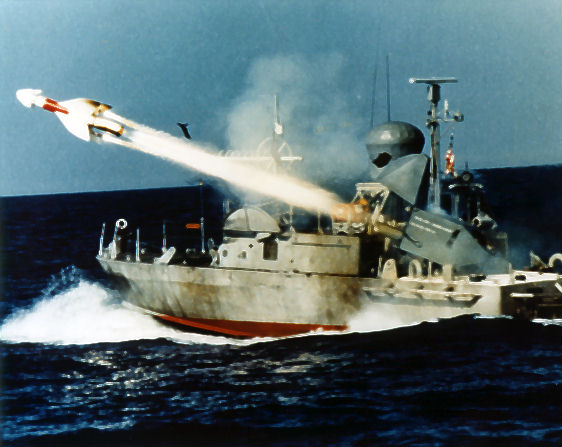PENGUIN FACT SHEET
By Cliff Lethbridge

Penguin Launch, Photo Courtesy U.S. Navy
Classification: Ship-to-Ship Cruise Missile
Length: 9 feet, 10 inches
Diameter: 11 inches
Wingspan: 4 feet, 7 inches
Mk 1 Range: 13 miles
Mk 2 Range: 19 miles
Date of First Cape Canaveral Launch: February 18, 1982
Date of Final Cape Canaveral Launch: April 8, 1982
Number of Cape Canaveral Launches: 9
A ship-to-ship missile designed by the Norwegian Defense Research Establishment, the Penguin missile was manufactured in the early 1960’s with the assistance of U.S. research and test facilities, including the range at Cape Canaveral. The Penguin employed a fully passive guidance system, since radio signals from the parent ship or the missile itself could be easily jammed during at-sea operations. A warhead system originally designed for the U.S. Bullpup missile was adapted for use on the Penguin. The warhead was built for the Penguin in Europe under U.S. license. The Penguin was deployed from a box-type launcher attached to a ship-board deck mount. Prior to launch, each missile remained attached to the ship by an umbilical connection. A total of six Penguin missiles were carried aboard Norwegian Storm Class fast patrol boats.
Targets were detected by ship-board instrumentation. Appropriate data was loaded directly to the Penguin’s guidance system, which functioned independently of the ship once the missile was launched. The Penguin’s box-type launcher was opened as the parent ship turned away. Once launched, the missile’s pre-programmed inertial guidance system, coupled with an infrared heat detector, provided automatic homing toward its target. The missile also had the capability of homing in on a target using a passive direction finder which sensed an enemy’s electromagnetic signature.
An improved version of the Penguin, called the Penguin Mk 2, added an active radar homing head to improve guidance toward a target. The Penguin Mk 2 was deployed on missile boats operated by Norway, Sweden, Greece, Turkey and the U.S. In the early 1970’s, the Penguin Mk 2 was modified to create a short-range ballistic missile. This version of the Penguin was used for fixed coastal defense as well as land-based mobile-launcher applications. In the mid-1970’s, the missile was further adapted under a joint agreement between Norway and Sweden. These nations converted the Penguin Mk 2 to an F-16 fighter-based air-to-surface missile. However, only the ship-to-ship version of the Penguin was ever launched using range facilities at Cape Canaveral.


